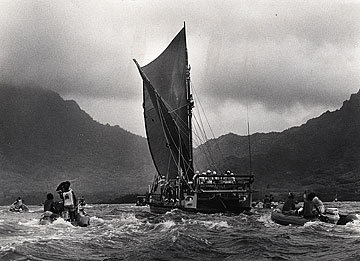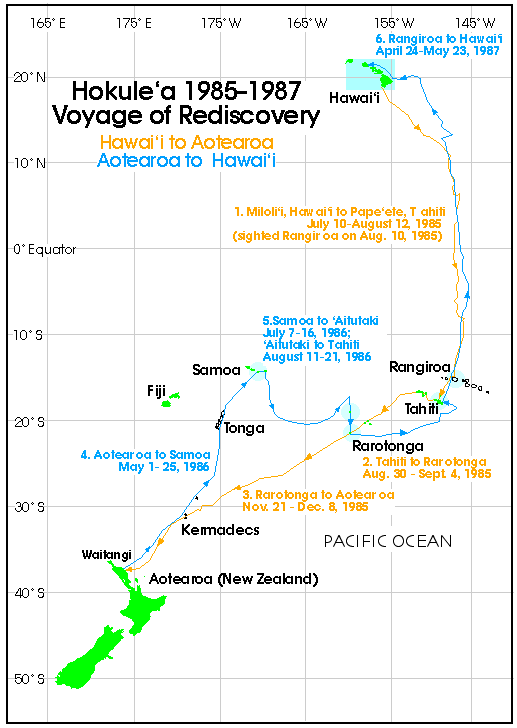Recollections of the Voyage of Rediscovery: 1985-1987
Nainoa Thompson
In 1980, when we returned from the voyage to Tahiti, we took Hokule'a to He'eia Kea, to a little inlet in Kane'ohe Bay. The voyaging community was small and after the trip we were exhausted. We went back to our own lives. In He'eia Kea there is a lot of fresh water in the ocean and a lot of rain, and some of the wood on the canoe began to rot. It was just total neglect by all of us. Finally, Wally Froiseth, a master woodworker who has contributed for years to the revival of canoe-building in Hawai'i, got up at a meeting and said, "We've got to take care of the canoe."

Wally Froiseth
So we went to He'eia Kea and hauled the canoe out of the inlet. There was a lot of growth on her hulls, and the shrouds and stays were all slack. The canoe was an absolute mess. When we finally set sail, the mast snapped because it was rotted. We took Hokule'a into dry dock.
Hokule'a was really built to sail just once-in 1976-for the Bicentennial of America celebration. We went again in 1980, to see if we could navigate by ourselves, to live our culture, and to honor Eddie 'Aikau. We received invitations from a lot of people in the South Pacific who heard about Hokule'a and wanted us to visit them, so we sat down and said, "Let's sail the migratory routes that our ancestors must have taken to colonize Polynesia." And so we started planning for the Voyage of Rediscovery ... rediscovering ourselves. We were not going to sail from Hawai'i to the Marquesas and for sure we were not going to sail to Rapa Nui. Those upwind routes were unrealistic. They were much too difficult at the time. We did not have the experience.
Crossing 1,700 miles from Rarotonga to Aotearoa, even though it's shorter than the trip from Hawai'i to Tahiti, would take Hokule'a the tropics and into the subtropics for the first time. I thought this would be the most dangerous of all the legs on this voyage. We were going into much colder water and much more complicated weather systems. From the beginning of November to the end of March-the Southern Hemisphere summer-hurricanes spawn in the Coral Sea, come up hurricane alley, through Tonga and Samoa, and head to the southeast. They cut right across the planned path of the canoe. They are infrequent but they do visit the North Island of Aotearoa. But there were advantages to sailing in summer. High pressure systems settle in and that's what you want, you want to be north of the high pressure center where you find trade winds. From Rarotonga we would sail west-southwest, so we needed trades.
So, in the summer the winds are ideal, but you get hurricanes. You don't want to go in winter because westerly wind bands move north and you're sure to get a head wind-hammering and cold-spun off from subtropical low pressure systems. We wanted to leave before the summer hurricane season and after the winter westerlies die off and the trades fill in, so we decided to sail in the springtime.
We took two years to plan. What would the strategy be? How were we going to navigate this route without instruments? Between Rarotonga and Aotearoa is a group of small islands called the Kermadecs. If we could find these islands along the way, we would know where we were. From there, instead of navigating 1700 of open ocean, we would have to navigate only 450 miles to Aotearoa.
Aotearoa is so much father south than Hawai'i, so the star patterns relative to the horizon are very different, and the navigational system we had been using doesn't work as well that far south. The farther you get from the equator, the less available for steering the stars around the north and south celestial poles become. When you go far to the south, the northern stars are below the horizon, the southern stars never rise and set, and the paths stars take in the sky get more and more horizontal. Steering by the rising and setting stars becomes much more difficult. The stars rise in their houses but then veer off sharply as they continue to cross the sky, so once they are up in the sky, it's hard to tell where they rose from and where they will set on the horizon.
I needed to go and study those star patterns. I knew from a scientific point of view that I had to train this way; but I also wanted to visit this land to get an instinctual feeling about it before trying to go there on the canoe. The only person I knew in Aotearoa was a man named John Rangihau, a man who possesses great mana-like one we would call a kahuna. I said to him in my kind of foolish innocence, "Mr. Rangihau, I need to go to Aotearoa, and I need to study the stars in the northern part of your island. I looked at a map, and I found a place called Te Reinga. It has a lighthouse. Can you pick me up and drop me off there? I'll live in the lighthouse; I'll take my own food. And when I'm pau, can you pick me up?" I had no idea what I was doing. I knew no one but him. And he said, "Okay, I'll do that."
So I flew to Aotearoa. I was 29 years old. I went through customs and no John Rangihau. All of a sudden I saw a very friendly lady with a banner with my name on it. She was waving it above her head, and I thought to myself, "Oh boy, things are not going the way I thought they would go." We went outside in the parking lot, and she put me in the back of her car. She had a comforter and pillows there to make a bed. And this was just one of the many, many gestures of caring shown to me while I was there. I was thinking, "Okay, we're going to Te Reinga," but when I mentioned this place, she said, "Oh no, we're going to Mangonui."
We we got to Mangonui, there was no house-just some tents and two caravans (trailer homes). It was Hector Busby's land, but I didn't know that. There was a place being excavated; I learned later it was for the foundation of the house Hector was planning to build.
We got out of the car and met some people on the beach. They were very friendly and told me, "Here is your tent. You can stay in this tent."
My stay had been arranged. They knew I was coming. I kept hearing this name "Hector Busby," but he wasn't there. He was out fishing. One of the guys named Matey Baker, a school custodian, said, "Hey, we set a net in the stream back where that bridge was, let's go pull it."
While we were walking there, he said, "I hear you know about the stars." So I started telling him a little bit about navigation and Hokule'a and what we were trying to do. He wasn't Maori and was only mildly interested, but it made good conversation. We walked to the bridge. Matey went under the bridge and I was up on top pulling the fish out of the net when Hector drove in with a couple of friends, wondering who was poaching his mullet.
He had his boat on a trailer behind him. He screeched to a stop and got out the car. He didn't say a word to me. He just stood on the bridge with his hands on his hips.
Matey came up from under the bridge and Hector quickly figured out who I was – "That's the Hawaiian coming down here to look at the stars and spoil my vacation." At least that's what I thought he was thinking. It was New Year's Eve, and everyone was on holiday for two weeks.
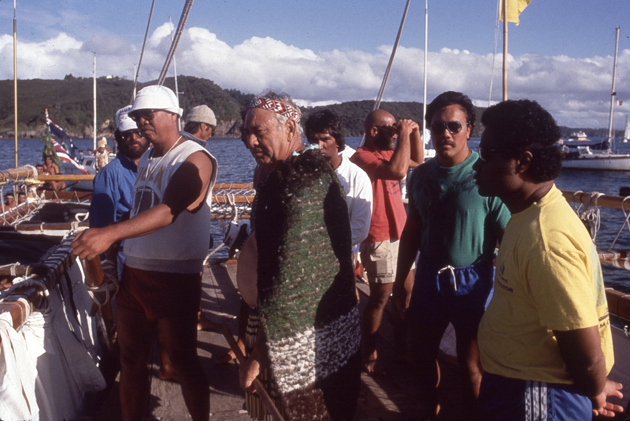
Matey came up and introduced me to Hector. Hector wouldn't even shake my hand. He just told me, "Go sit in the boat." Everybody else was sitting in the car. So I got into the boat, and we went tearing down the road. I wondered what was going on. He didn't say hello. Didn't shake my hand. Nothing. He didn't even acknowledge the introduction.
By the time we got to the beach, I was thinking, "I don't feel welcome here. This is not set up right. I don't know what John Rangihau was thinking. Here is a man with so much mana that he's considered a prophet. What in the world was he thinking by sending me here?"
All I wanted to do at that point was to go to the lighthouse to study stars, but I didn't have a ride there and the lighthouse was an hour and a half away. So we got out of the car and everybody was nice to me except Hector. Hector's wife was very angry about the way he was treating me. Then Matey said, "Oh, so we hear you're a navigator, so why don't you tell us where north is?"
Matey didn't mean anything, just being friendly; but Hector turned to me and I could see the glare in his eyes. Then he ran into his car and got a compass, but kept it hidden. He was looking at me through the windshield. Matey and everybody was politely waiting for my answer. They were not testing me, but Hector was. I could see him with that compass box.
Luckily it was late afternoon, and the sun was setting. I took my time. In front of us was a bay that goes out to a point. I said, "I think north is over here."
Hector waited a few minutes, checking his compass, then came running out of his car and said, "No, no you're fifteen degrees off."
By then people there were mad at Hector. And one of them, Joe Nara, who was a navigator in the Royal Air Force in New Zealand, said to Hector, "Which way?"
Hector said, "He's too far off to the left."
Joe said, "Yes, because your compass variation is off by thirteen degrees. He's only two degrees off."
Hector closed his box and walked away angrily.
After things calmed down a little, I was getting excited about studying stars, so I couldn't wait for it to get dark. When it got dark, I excused myself from the family and walked away from the camp to get away from the lights. Matey's son was really attracted to the whole idea of studying the stars, so he came with me. We went up on a little grassy hill. I had my charts, my books, and a little flashlight. We studied the stars. Then about midnight I decided to go back to the camp to wish everyone a Happy New Year and to thank them for their kindness.
Hector was sitting by the campfire. Suddenly he got up and began to orate in Maori. I didn't know what he was saying, but I could see in the yellow light from the lanterns tears streaming down his face.
When he finished he said, "In this land, we still have our canoe buried. In this land, we still have our language and we trace our genealogies back to the canoes our ancestors arrived on. But we have lost our pride and the dignity of our traditions. If you are going to bring Hokule'a here, that will help bring it back. Whatever you need to do, I am with you all the way."
When he first met me, all Hector knew was that I was some Hawaiian who wanted to come down and study the stars, but he didn't know why. When I was up on the hill, I think Matey told him about Hokule'a and what we were trying to do. Somehow, John Rangihau knew that Hector would be the one to care for me.1
From that point on, all during his vacation, Hector drove me to places where I could study the stars. We drove a long distance to Te Reinga, the northern tip of the island. The beach there was ninety miles long. We went to the lighthouse, and from there, I could see the horizon to the east, west, and north. At night, I would study the stars and Hector would sleep in the car. At dawn, he would drive back while I would sleep in the car.
At the lighthouse, there was a cave where a pohutukawa tree grew – the same as our 'ohi'a lehua.
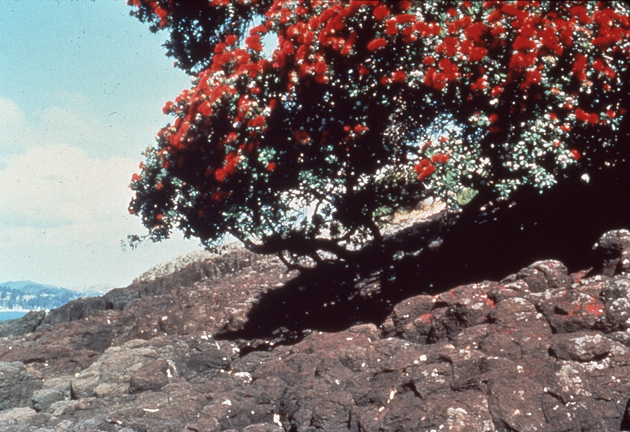
In the myth of Kupe, the navigator who first discovered Aotearoa, the sailing direction to Aotearoa from Hawaiki-the homeland-was to steer to the left of the setting sun in the season when the pohutukawa blooms. That is late spring, early summer in the Southern Hemisphere, when our voyage was scheduled to depart. And like Kupe, we would leave from Rarotonga.2
Te Reinga is a sacred place. When a Maori dies, his spirit goes there to dive into the sea and return to Hawaiki, to the home land. All of these myths and Maori language and oration were new to me. The first time I ever participated in a Hawaiian ritual was when Hokule'a was launched in 1975. When I first got to Aotearoa, I didn't understand that these myths could provide valuable information for the voyage-I was there to study the stars.
When my studying at Te Reinga was over, Hector took me back to the Bay of Islands. He drove off in tears.
That's how my connection with Hector began. It went from Hector not shaking my hand to his staying with me all the way and my becoming a part of his family. I think for him the canoe made his history and the honor and dignity of his culture-which he knows so well-come alive. Hector is an advisor to the people in the Northern Museum about Maori history because he knows so many of the old stories. He's a living legend in his own world.
You see from this story that voyaging is not about one person. It requires many, many people. My relationship with Hector enriched my life in a way that I could never have imagined before I went to Aotearoa. I went back home renewed and studied harder. The purpose of sailing Hokule'a to Aotearoa went beyond applying science or reviving culture; it was also about connecting people and restoring pride.
In 1985, we sailed down to Rarotonga from where we would depart for Aotearoa.3 We went to Muri, where there are seven stones representing seven canoes that left for Aotearoa. The navigator Kupe also left from there on his voyage of discovery to Aotearoa. A pod of whales helped him find his way. So we waited at Muri for the right weather conditions to go. We hoped to leave around November 15.
As we waited, a tropical cyclone roared up hurricane alley, out of season, with sixty knots of wind. Only three more knots and it would be classified a hurricane. Once a cyclone cuts through the atmosphere it tends to create a path for others to follow. We were looking at the possibility of an early hurricane season which would not allow us to go. Along with the tropical cyclone near Rarotonga, New Zealand was experiencing a late winter, with subtropical lows-the two worst conditions for sailing to Aotearoa. I was frankly afraid to go because there were so many people's lives at stake. I was in my early thirties, and I didn't have the confidence and the maturity to be handling that kind of pressure. I was panicking.
I talked to my dad: "What if we have to shut this thing down? What if the hurricane season starts early?"
He said, "Just make the best choice. Take in all the information and make your choice. Whatever choice you make, we will support it."
I went back and forth with the meteorologists, day after day. Now my father was beginning to get concerned because he saw how concerned I was. He began to step back and be more conservative with his recommendations. We started to lose our confidence. Then Hector arrived and heard about our uncertainty. The next morning he came into my room while I was trying to make a decision, and he said, "You must go. You have to go. And you will get there because your ancestors will be with you." He would not discuss the possibility of not going. He reminded me, "When we were studying the stars I told you that we would be with you all the way." He was powerfully adamant. That removed any question about not going. Hector changed the momentum from more and more doubt to a feeling that this was not a decision, it was fate. For him it was not an intellectual decision making process. He just said, "You must go." And so we did.
There was a break in the weather: another storm came through, but behind it there was no sign of another one so off we went. It took about six hours for Rarotonga to go below the horizon at our stern. It was an incredible voyage, with very special moments. We had an incredible crew, a crew of common people, from all walks of life, bonded by a single vision.
One special moment came while we were trying very hard to find the Kermadec Islands to give us that known point along the way. If we sailed too far south, we would run into westerly winds, and if we ended up east of New Zealand in westerlies, we would have to tack against them for days. But if we didn't sail far enough south and turned west too soon we ran the risk of sailing past the top of North Island and ending up in the Tasman Sea without knowing it.
One night we saw two stars, Alpha and Beta Centauri, right on the horizon and that gave me a lot of confidence that we were at the latitude of the Kermadecs, which I thought were to the west. So we headed west.4 The next day we were looking into the sun which made the water sparkle, and we didn't see a pod of sperm whales coming-about eighteen of them. We sailed right into the middle of the pod. I don't know why, but one of the whales-perhaps it was a mother who had become separated from her calf-turned from the north and swam toward our starboard side with such force that her whole head rose out of the water. She came right to the hull of the canoe, then at the last moment, dove down and turned her tail. Instead of ramming us, which would have permanently damaged the canoe, she just kind of nudged us to the south. From a scientific point of view this event had no value. We were just lucky we were still afloat. We continued heading west toward the setting sun, looking for the Kermadecs.
That afternoon, a squall came out of the north, not an ordinary squall, but one in which the cloud touches the water, and there was forked lightning. The winds dropped, and the clouds came upon us. And then I said, "Let's turn south. Forget the Kermadecs, this is too dangerous." Since the canoe was high on the water, it could have attracted a hit from the lightning. So we turned south and sailed into a mist.
We were just trying to sail away from the lightning. I gave up trying to find the Kermadecs. I didn't know if this was a good decison or not; I made it out of fear. We found ourselves sailing in a very thin mist. We sailed in that mist all night-just trying hard to keep the canoe on track, struggling to steer. I will always remember that night-we couldn't see the stars, but we could see Venus and Jupiter through the mist. We sailed on, lightening all around us.
When the first light of dawn came, I was exhausted. The first light of dawn is always a time when I feel a sense of relief because now we can see what we're doing. I collapsed, I was out. I slept through sunrise.
Then there was a commotion among the crew. I looked up and saw Maori crew member Stanley Conrad shaking Shorty Bertelmann awake; Stanley was so exicted he couldn't talk, he was just pointing. The Kermadecs were right there. We had already passed one island and another one was ahead of us.
It was like a gift. Sometimes navigation is far out of our own hands. First the whale nudged us to the south. Later we guessed the whale might have been a cow who we had separated from her calf. But there might be another explanation-it may have been a sign from our ancestors. Kupe had a similar experience on his voyage to Aotearoa. Later, we turned south because of the lighting, and we found the Kermadecs. These moments are what make voyaging special. After that, we knew where Aotearoa was. The rest of the voyage was relatively easy.

During this voyage, we wore survival gear, and, throughout the whole voyage, we talked about the incredible strength and endurance of the Maori people. Consider that they occupied islands below Aotearoa at 60 degrees South. That's equivalent to us sailing to Alaska, without foul weather gear. That's not something that we could do. I tried my hardest one night to experience the cold, and we were only halfway there, at 30 degrees south. We know of chants of legends and genealogies speaking of white floating islands and birds that fly through the water-icebergs and penguins. We were in awe of the strength of those ancestors.
We arrived in Aotearoa [on December 7, 1985, sixteen days after departure from Rarotonga]. It was a special moment for Stanley Conrad, the son of a fisherman from the North Land, chosen by his people to represent Aotearoa. Stanley was a young man, and his father was worried because he knew the dangers of such a voyage. But Stanley performed extremely well. He had crossed 1,700 miles of ocean to get home, and he had crossed it in a canoe, like his ancestors had. As we approached his homeland, he said nothing, I think because the experience was too powerful for him. It certainly was for us. The Maoris came out to greet us in Nga Toki Matawhaorua, with 88 paddlers. Hector's group had relaunched this canoe to help revive Maori ocean traditions. We heard them chanting before we saw them. And then we saw the canoe rise on the top of a crest and settle back down in a trough. It was awesome.

To me, it was such an important time for Stanley standing there in the rear, as it was for us. The joining of two canoes was the joining of two cultures. These two cultures have a common ancestry. This was not a meeting of people, it was a reunion. These experiences are what have made the voyages so important. And there was Hector Busby fulfilling his promise that he'd be there all the way, hoping and praying for us like the others, like any parent would. I was very happy to see him that day, because we completed the dream he said that our ancestors would support.
After we landed, we were invited to a very special occasion at the marae at Waitangi. We were greeted in the traditional way.
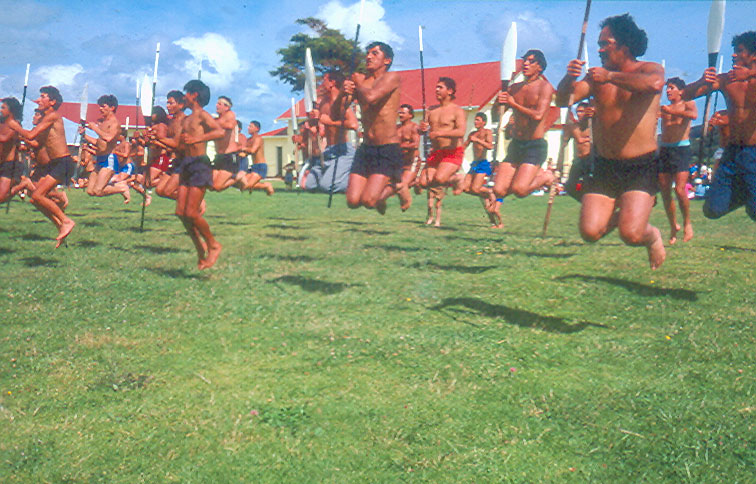
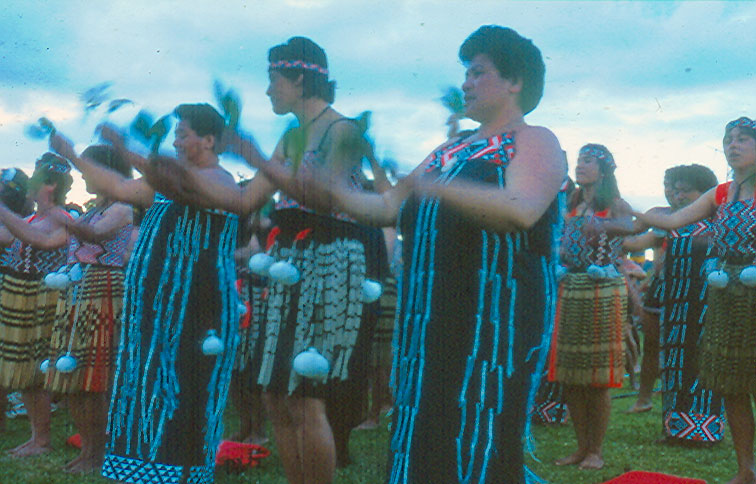
We learned that the marae houses wellness for the Maori people. We watched grandchildren and grandparents dance together and sing together. We understood that these marae housed not just people, but the genealogies by which they traced their ancestry back to the canoes that brought them to Aotearoa. I can see how connected the Maori are to their ancestry. And because they are connected to their past, I believe that it's much easier for them to see the kind of future they want to voyage to. This was another part of our own work toward renewal.
Sir James Henare, the most revered of the elders of Tai Tokerau, got up and said, "You've proven that it could be done. And you've also proven that our ancestors did it." On this very special occasion, he laughed and he cried. I recognized from him that we already come from a powerful heritage and ancestry. The canoe, on its voyages, is just one instrument to connect to that. Sir James Henare also made an incredible statement: "... because the five tribes of Tai Tokerau trace their ancestry from the names of the canoes they arrived in, and because you people from Hawai'i came by canoe, therefore by our traditions, you must be the sixth tribe of Tai Tokerau." We didn't know what to make of such a powerful statement. In a few sentences, Sir James Henare had connected us to his people. And he said that all the descendants from those who sailed the canoe are family in Tai Tokerau.5
When it was time to leave Aotearoa, we couldn't go on schedule because we had very bad weather conditions. We had to wait twenty-two days. Hilda, Hector Busby's wife, said, "When you're in my land, I am your mother and you are my children. So I will take care of you and stay with you all the way." Twenty-two days we were housed. Twenty-two days she fed us three times a day. Twenty-two days she washed our clothes. We were cared for like family. I saw that the quality of my life was determined by the kinds of relationships I have with others. When I had this dream of sailing to Aotearoa, I went there alone to sleep in the lighthouse at Te Reinga; I never imagined how important it was to be connected with people.
Hokule‘a sailing into Kane‘ohe Bay at the end of the Voyage of Rediscovery, 1987. Star Bulletin Archives.
Notes
1. For more on Hokule'a's voyage from Rarotonga to Aotearoa and the traditions of the Maori migrations to Aotearoa, see Ben Finney's Voyage of Rediscovery: A Cultural Odyssey through Polynesia (163-196). One version of the story of Kupe's voyage to Aotearoa is included in the voyaging mo‘olelo on this website.
2. Under Hector Busby's leadership, "the Maori people of the far north of the North Island had formed the Tai Tokerau Cultural Assocation in 1973 to relaunch Nga Toki Matawhaorua, a giant Maori paddling canoe 136 feet long named, we were told, after a legendary canoe that had made a second voyage from Hawaiki to Aotearoa after having been re-carved or, as its name translates, having been "by adze hollowed out twice." The modern [replica] had been constructed for the 1940 centennial of the Treaty of Waitangi between the British and Maori tribal chiefs. The idea behind the relaunching was to employ Nga Toki Matawhaorua as a focus for cultural revival among the Northland tribes, much as Hokule'a had been conceived as a vehicle for rekindling Hawaiian pride in their voyaging heritage" (Finney Voyage of Rediscovery 190-191). Hector's interest in canoe traditions was no doubt the reason why John Rangihau sent Nainoa to him.
3. Hokule'a left Miloli'i on the Big Island of Hawai'i on July 10, 1985 and arrived in Pape'ete, Tahiti, on Augst 11, 1985. On August 30, she left Pape'ete and arrived in Rarotonga on September 14.
4. Nainoa notes: "After I returned home Will Kyselka explained to me why I was off in estimating my latitude with Alpha and Beta Centauri-why I turned west for the Kermadecs too soon. When stars are close to the horizon, their light can be refracted by half a degree as it comes over the curve of the earth. So we were actually half a degree north of where we thought we were."
5. Ben Finney's Voyage of Rediscovery: A Cultural Odyssey through Polynesia (196-201) gives a detailed account of the welcoming ceremonies when Hokule'a arrived at the Bay of Islands.
Crew Lists
Hawai'i - Tahiti (July 10, 1985 - Aug. 11, 1985): Navigator: Nainoa Thompson; Captain: Shorty Bertelmann; Crew: Clay Bertelmann, Dennis Chun, Richard Tai Crouch, Harry Ho, Dr. Larry Magnussen, Buddy McGuire, Mau Piailug, Thomas Reity, James Shizuru, Tava Taupu
Tahiti - Cook Islands (Aug. 30 1985 - Sept. 14, 1985)--Navigator: Nainoa Thompson; Captain: Gordon Pi`ianai`a; Crew: Dr. Patrick Aiu, Snake Ah Hee, Chad Baybayan, John Kruse, Vic Lipman, Mel Paoa, Mau Piailug, Abraham Pi`ianai`a, Chad Pi`ianai`a, Michael Tongg, Andrew Tutai (Cook Islands), Peter Sepelalur, Leon Sterllng, Cliff Watson, Bob Krauss, journalist, was a crew member from Tahiti to Raiatea
Cook Islands - Aotearoa (New Zealand) (Nov. 21, 1985 - Dec. 7, 1985): Navigator: Nainoa Thompson; Captain: Shorty Bertelmann; Crew: Dr. Patrick Aiu, Chad Baybayan, Bruce Blankenfeld, Stanley Conrad (New Zealand), Dr. Ben Finney, Harry Ho, Buddy McGuire, Billy Richards, James Shizuru, Leon Sterling, Tava Taupu, Michael Tongg
Aotearoa - Tonga (May 1, 1986 - May 11, 1986): Navigator: Nainoa Thompson; Captain: Leon Sterling; Crew: Snake Ah Hee, Dr. Patrick Aiu, Carlos Andrade, Chad Baybayan, Philip Ikeda, John Keolanui, Kimo Lyman, Mau Piailug, Scott Sullivan, Michael Tongg, Sione Ula (Tonga)
Tonga to American Samoa (May 23, 1986 - May 25, 1986): Navigator: Nainoa Thompson; Captain: Leon Sterling; Crew: Dr. Patrick Aiu, Carlos Andrade, Gil Ane, Gail Armstrong, Chad Baybayan, Hector Busby (New Zealand), Philip Ikeda, Sam Ka`ai, John Keolanui, Kimo Lyman, Mau Piailug, Scott Sullivan, Jo Anne Sterling, Sione Taupeamuhu (Tonga), Michael Tongg, Sione Uaine Ula (Tonga)
American Samoa to the Cook Islands (July 7, 1986 - July 16, 1986): Navigator: Nainoa Thompson; Captain: Shorty Bertelmann; Crew: Clay Bertelmann, Harry Ho, Pauahi Ioane, Bernard Kilonsky, Ben Lindsey, Mel Paoa, Mau Piailug, Tua Pittman (Cook Islands), Tava Taupu
Cook Islands to Tahiti (Aug. 12, 1986 - Aug. 21, 1986): Navigator and Captain: Nainoa Thompson; Crew: Dr. Patrick Aiu, Snake Ah Hee, Chad Baybayan, Bruce Blankenfeld, Wallace Froiseth, Harry Ho, Glen Oshiro, Mau Piailug, Richard Rhodes, Michael Tongg, Aaron Young
Tautira, Tahiti - Pape'ete, Tahiti (One-day sail, Mar. 27, 1987): Navigator: Nainoa Thompson; Captain: Chad Baybayan; Crew: Wallace Froiseth, Harry Ho, Kilo Kaina, Michele Kapana, Will Kyselka, Russell Mau, Abraham Pi`ianai`a, Tutaha Salmon (Tahiti), Cary Sneider, Tava Taupu, Michael Tongg, Aaron Young
Tahiti - Rangiroa (April 2, 1987 - April 4, 1987): Navigator: Nainoa Thompson; Captain: Chad Baybayan; Crew: Clay Bertelmann, Wallace Froiseth, Rey Jonsson, Sol Kahoohalahala, Will Kyselka, Charles Larson, Mel Paoa, Cary Sneider, Tava Taupu, Michael Tongg, Cliff Watson, Dr. Nathan Wong, Elisa Yadao, Aaron Young
Rangiroa - Hawai'i (April 24, 1987 to May 21, 1987 Hilo; May 23,1987, Kualoa): Navigator: Nainoa Thompson; Captain: Shorty Bertelmann; Crew: Snake Ah Hee, Dr. Patrick Aiu, Chad Baybayan, Bruce Blankenfeld, Stanley Conrad (New Zealand), Eni Hunkin (Samoa), Tua Pittman (Cook Islands), Dixon Stroup, Puaniho Tauotaha (Tahiti), Sione Taupeamuhu (Tonga), Tava Taupu, Michael Tongg, Cliff Watson, Elisa Yadao.

